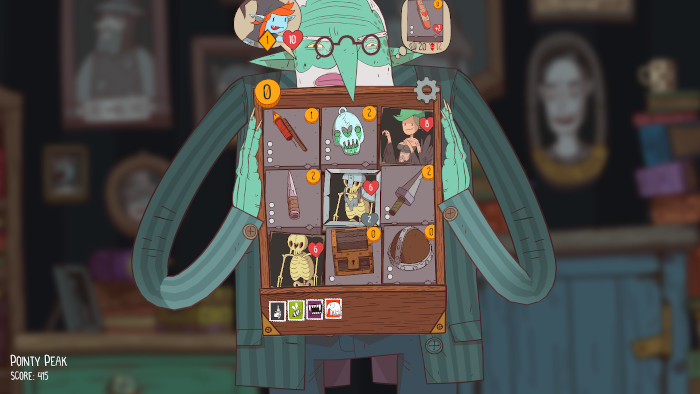Meteorfall: Krumit's Tale
Reviews
Please sign in or register to add your own review.
Titles like Slay the Spire (2017), Griftlands (2019) and Inscryption (2021) have defined the genre of roguelike deck-building games where you combat enemies using playing cards. Can small indie studios still bring something new to the crowded genre?
With Meteorfall: Krumit’s Tale, Slothwerks, founded by developer Eric Farraro, is building on the success of its earlier Android/iOS game, Meteorfall: Journeys. Both games feature an art style inspired by Adventure Time and are set in a fantasy world that includes magic, monsters, aliens, and robots.
The intro screen for Krumit’s Tale depicts the outside of Krumit’s cozy house. After you start the game, the aging dungeon-master—who looks like he is part goblin, part elf—quickly invites you in to choose a character and to begin playing a game of cards.

Dungeons are represented by a 3x3 grid of items, abilities, and enemies, with Krumit commenting on your actions in the background. (Credit: Slothwerks. Fair use.)
Dungeons on rails
You find yourself facing a 3x3 grid of cards, which include items, abilities, and enemies. You can discard cards to recover health and to gain coins. You can then spend coins to purchase items and abilities, which are added to your hand of up to four cards.
After cards are removed from the grid, Krumit deals new ones, until there are none left in the deck. Combat is turn-based and driven by simple stats (attack, defense, health). In most cases, you have the first move.
In spite of the title promising a “tale”, there’s little to no story as you advance from dungeon to dungeon randomly. Krumit himself is quite chatty and comments on many of your actions with one-liners; he also introduces bosses when they appear on the board.
As is typical for the roguelike genre, death is permanent. This makes for very tight “runs” that typically last 20-40 minutes.

One of the weaknesses of the game is that you don’t get to choose where the journey goes: Krumit navigates the map for you. (Credit: Slothwerks. Fair use.)
Deceptive simplicity
The game quickly introduces its core mechanics, while providing concise on-screen explanations for all cards. Each of the five unlockable heroes has access to a different set of abilities and items, forcing completely different play styles.
The wizard can burn enemies from afar, causing them to take damage as they move down the grid. The necromancer turns enemies into tombstone cards, which he can then raise to fight in his stead. The rogue is weak, but gains stealth against enemies with no neighbors on the board.
Enemies are similarly varied, from robots that self-destruct to town guards that prevent you from using melee weapons until you defeat them.
To knock out the most powerful bosses, you need luck on your side, but the game also requires strategy to make the best of the cards you’re dealt. After each victory, the game awards you with gems depending on how well you did. You can use these to purchase higher quality cards for the next dungeon.
The Verdict
I am really enjoying my time with Krumit’s Tale and have added it to my list of evergreens that I’m likely to return to time after time. Overall, I would give the game 4.5 stars, rounded up. Its core strengths are:
-
Excellent game design. There’s very little fat here—no tedious tutorials, no nested menus, no complicated rules. Krumit’s Tale is very easy to pick up but difficult to master; you’ll incorporate many new systems and strategies into your play as you go.
-
Gorgeous art direction. Heroes and enemies are lovingly drawn and animated; items are recognizable and distinct. If you like the Adventure Time art style, you’ll feel right at home—much credit to artist Evgeny Viitman.
Krumit himself (voiced by Adrian Vaughan) adds character and flair as well. After more than 10 hours of play, I’ve still not turned on the user preference to make him less chatty! Only the music, which sets a fitting tone of mystery and adventure, gets a bit repetitive. -
Attention to detail. Dungeons and items are accompanied by short but amusing quotes and descriptions. Little indicators appear in the user interface when you gain health or coins. I’ve encountered virtually no bugs and no crashes. Playing Krumit’s Tale feels smooth in the way only the best games do.
The most noticeable weaknesses are:
-
You have no agency about which dungeons to enter—Krumit makes that choice for you. That means you’ll often be dumped in dungeons that you simply have no chance of winning, even with a good strategy.
-
There’s no overarching motive or story. You’re just some adventurer who likes to defeat monsters and collect loot. The enemies, too, seem to have no articulated intentions other than to kill you.
-
As gorgeous as the artwork is, the game doesn’t attempt any real worldbuilding. There are no character sheets for our heroes or more detailed descriptions of the monsters, for example.
The combination of tight gameplay and shallow story is typical for mobile games. As Slothwerks makes the transition to large screen games, many players will expect a more fleshed out experience. Still, I would highly recommend Krumit’s Tale if you find the art style appealing and enjoy roguelike games that can, at times, be utterly unfair.
While I would love to see a native Linux version, I played Krumit’s Tale on Linux using Steam/Proton without issues.
About
-
Additional links play.google.com/store/apps/details?id=com.slothwerks.krumit -
Show uploaded media
Uploaded media:
krumit-map-1639986967181.jpg
One of the weaknesses of the game is that you don't get to choose where the journey goes: Krumit navigates the map for you.Credit: Slothwerks. Fair use.Source: own screenshotkrumit-1639986828113.jpg
Dungeons are represented by a 3x3 grid of items, abilities, and enemies, with Krumit commenting on your actions in the background.Credit: Slothwerks. Fair use.Source: own screenshot